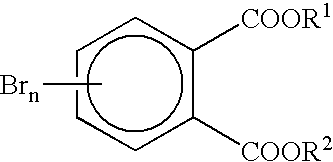Flame retarded styrenic polymer foams
- Summary
- Abstract
- Description
- Claims
- Application Information
AI Technical Summary
Benefits of technology
Problems solved by technology
Method used
Image
Examples
example 1
Compression Molding--Example 1
[0041] Before compression molding, the respective batches are first ground through a 4 mm sieve. Then 115 g of the ground material is poured into a 190.times.190 mm insert at room temperature. The insert containing the ground material is put between heated platens at 180.degree. C. for 1 minute at about 20 kN. Then a pressure of 200 kN is applied for 7 more minutes. The insert is then cooled between 2 other platens at 20.degree. C. for 8 minutes with a pressure of 200 kN. A plaque of 190.times.190.times.2.75(.+-.0.15) mm is then removed from the mould. Two plaques of 95.times.95 mm and 17 bars of 10.times.95 mm are cut out of the larger plaque. The bars were used for LOI evaluations.
Compounding and Compression Molding--Example 2
[0042] For the test specimens of Example 2 which used the flame retardant at a higher loading, the same compounding and compression moulding procedure as above was used except that 1.70 g of bis(2,3-dibromopropyl)t-etrabromophtha...
PUM
| Property | Measurement | Unit |
|---|---|---|
| Particle size | aaaaa | aaaaa |
| Fraction | aaaaa | aaaaa |
| Fraction | aaaaa | aaaaa |
Abstract
Description
Claims
Application Information
 Login to view more
Login to view more - R&D Engineer
- R&D Manager
- IP Professional
- Industry Leading Data Capabilities
- Powerful AI technology
- Patent DNA Extraction
Browse by: Latest US Patents, China's latest patents, Technical Efficacy Thesaurus, Application Domain, Technology Topic.
© 2024 PatSnap. All rights reserved.Legal|Privacy policy|Modern Slavery Act Transparency Statement|Sitemap


